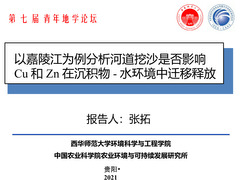Does sand mining affect the remobilization of copper and zinc in sediments? — A case study of the Jialing River(以嘉陵江为例分析河道挖沙对铜锌在沉积物中的迁移的影响)
编号:1606
稿件编号:493 访问权限:仅限参会人
更新:2021-06-22 17:22:15
浏览:1491次
口头报告
摘要
Sand mining industry was generally accepted to cause a severe destruction to the river basin environment. In this study, six sediment cores were collected and applied sequential extraction in conjunction with diffusive gradient in the thin films (DGT) technique to explore the effect of sand mining on the remobilization of Cu and Zn in the sediment. The results showed that Cu and Zn was mainly bound in F4 fraction in the sediment. CDGT-Cu/Zn in the sediment presented obvious increasing trends at the bottom (-10 to -12 cm) in the four sites experienced sanding mining while decreasing trend in the sites with no sand mining disturbance, meanwhile Cu and Zn also had the trend to transport from sediment to overlying water at four sand mining sites. A correlation analysis found that F1 and F3 correlated well with CDGT-Cu/Zn indicating the water/exchangeable fraction and oxidized fraction are the main fractions that lead to increment of DGT-labile Cu and Zn in the sediments. A further analysis found that the introduction of oxygen (O2) was the main reason that caused a simultaneously release of sulfur (S), Cu and Zn in the sediments as an evidence was observed that “dark area” of AgI gel appeared at the same position with “hotpsot area” of chelex gel. Two main sand mining effects on the release of Cu and Zn were hypothesized: (1) intense sand disturbance leads to transfer of the water/exchangeable fraction (F1) to the DGT-labile fraction; (2) O2 introduction promotes the reaction of stable sulfide (F3), thus tranfers to the DGT-labile fraction.The above results indicated that sand mining industry should be paid highly attention in the Jialing River as this can obviously causes the labile Cu and Zn release to the water.
关键字
Sand mining; sediment; Jialing River; DGT

发表评论